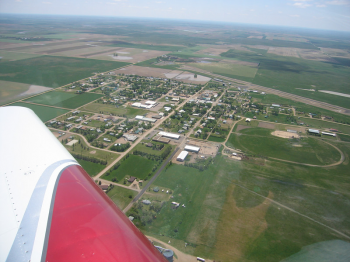Dish Towns USA (or Rural Screens) Part One
by: Joan Hawkins / Indiana University-Bloomington

As Gregory Waller has noted, much of what we know about screen history derives from urban experience (Waller 2002). This is certainly true of television history; television business practices, consumption patterns and saturation levels are simply easier to track across dense city populations than across sprawling—frequently transient—rural ones. I was reminded of this the other night at dinner, as I told some friends about my experiences visiting what I came to think of as “Dish Towns” in the northern plains states, over a three year period beginning in 2002.
Dish Towns are sparsely-populated enclaves of farmhouses and small town dwellings—sometimes spanning as much as three hundred miles of state roads and highways—that pepper the landscape across rural America. This is a landscape marked mostly by farms and prairie grass. Rusting tractors and gasoline pumps sometimes perch on hilltops, a testament to the increasing pressure on small farmers to sell and move on. It is also a landscape marked by hundreds of TV satellite dishes.
I call these enclaves Dish Towns, rather than Dish Networks, specifically in order to link them to the immigrant Dish Cities, described by Hamid Naficy (Naficy 1993) and others. Like densely populated urban immigrant communities, the rural population I am describing depends on satellite dishes to maintain contact with a perceived “home” culture. The fact that rural dish users reside in the country whose culture—without the dish—is so frequently unavailable to them is one of the things we need to take into account when we discuss audience.
The back story
In 2001 my 84 year old mother left San Francisco and moved back to the tiny South Dakota town where she had been born. Shortly after she moved, she suffered a debilitating stroke. Unable to care for herself and too frail to move closer to her children, she moved into the nicest rest home I could find. And I began the period of my life that my son calls my On the Road phase—making six trips a year to a part of the country about which I knew very little.
The first thing you learn as you drive across the northern plains states is just how large this country is. I mean really learn it, in a visceral way, rather than as some abstract notion. There are long expanses of road—sometimes as much as 200 miles—where you don’t even see a farmhouse. Signs are often misleading; and you quickly learn to fill the gas tank where you can, since some towns are too small and impoverished to support even a single commercial pump. Radio reception is poor; cell phone use is frequently impossible. “Rest stop” can mean anything from the full service oasis most of us are used to (indoor restrooms, a place to walk the dog, vending machines) to a picnic table and benches chained to a cement block by the side of the road. “This is where our ancestors used to hallucinate from thirst, go mad and die,” my husband would grimly quip. Frequently we saw animal carcasses and skulls on the roadside; there was a lot of roadkill.

The second thing you learn is how hard it is to get good TV. To begin with, there are simply fewer channels. A quick look at the West River Cable Television website confirmed this. In Bloomington, Indiana (pop. 120,563) where I reside, the basic no-frills cable package includes 65 channels. In the area comprising Minot, Dickinson, and Bismarck, North Dakota, basic cable includes 39 channels. It also costs more—$25 per month compared to the $19.99 which basic cable subscribers in Bloomington pay. This discrepancy—higher costs for fewer channels—extends all the way across the spectrum. Digital cable in Bloomington costs $40 a month for 200 channels; digital cable in the West River area costs $60 month for sometimes as few as 100 channels. The maximum number of cable channels available in this region is 195 (as a point of comparison, at the time of this writing a two bedroom, two bathroom house in Minot, North Dakota rents for approx $525 a month; a two bedroom apartment rents for $300; in Bloomington, rents are more than double that amount).
In the small motels I came to know so well, cable reception was terrible.
At first I thought this was simply the fault of the TV sets themselves. These were low budget operations and the sets were frequently ancient. But soon I noticed that even the more upscale places—the Travel Lodges and Hamilton Inns which provided brand new sets–had trouble consistently offering a quality picture. Turner Classic was not available at the Mirror Lodge motel in Hettinger, North Dakota; neither was CNN. Good Morning America became one of my most reliable sources of national news during long stretches of my many trips. Local newspapers frequently do not cover international news at all and only cover national news that is of immediate local interest (a group of North Dakota soldiers is sent to Iraq, for example). Even in urban corporate stores —the Starbucks in Bismarck, North Dakota and the Borders in Rapid City for example—it was difficult to find a copy of The New York Times dated for the date of purchase. As a result, whenever I moved outside an area that could pick up CNN or NPR (which was all too often) I also lost the ability to get reliable, extensive news coverage that was less than two days old.
Access to Hollywood is frequently as limited as access to Washington D.C. The town of Hettinger, North Dakota (pop 1,574) has one tiny single screen movie theater. The bill changes weekly. Films are shown Thursday through Monday in a single screening at 7:30 p.m. If the film of the week is kid-friendly, there is an additional Sunday Matinee. On Thanksgiving weekend, 2003, the theater was screening
No wonder, then, that the further into the plains I drove, the more TV satellite dishes I saw—not just attached to small town houses, but also attached to farmhouses and little country churches located on desolate strips of highway. Dish TV is really the best option for staying connected that residents of the northern plains have (regional internet connections have their own vexed histories). TO BE CONTINUED
Works Cited
Hamid Naficy, “Exile Discourse and Televisual Fetishization.” Otherness and the Media: The Ethnography of the Imagined and the Imaged. Hamid Naficy and Teshome Gabriel, eds. USA: Harwood Academic Publishers, 1993. 85-117
Gregory Waller. Moviegoing in America: A Sourcebook in the History of Film Exhibition. Malden MA: Blackwell, 2002.
Image Credits
1. The Small Dish Town of Bison, South Dakota
2. From the West River Cable Television Website
Please feel free to comment.
I wonder how these sorts of shifts in the media technology landscape as we travel from urban or semi-urban to truly rural are reflected by the availability and use of other media technologies. I would assume patterns of use and availability for radio, telephone, and internet are also quite different. I wonder if some of these things are different in similar ways. The author’s note about the newspapers and radio certainly seems to imply this.
This piece has disturbing implications in terms of rural populations’ access to a broad spectrum of political news. As the author notes, access to mainstream sources such as the New York Times, NPR and CNN, all of which are considered to be more politically “liberal” than other mainstream fare, are largely absent.
I wonder if this is a problem that plagues most of the rural parts of this country, which also tend to vote for conservative candidates even when the more progressive candidate offers more a tangible, positive impact on their lives. Is the absence of these sources a question of supply and demand — there simply is no audience for them? — or one of a deliberate top-down decision by the area’s cable providers to restrict this information from the citizenry? While the internet itself can help to solve this problem, such a solution requires individuals knowing what sources to seek out and investing the time necessary to view them. (Let alone a broadband connection if you want to view some video news reports.)
Even if it is simply a case of meaningless omission (as clearly not all channels and sources can be carried), this lack of informational access constitutes a significant problem for these rural residents.
Thank you for this essay. These are crucial issues, key also to my own scholarship (and personal formation). Just fyi, others who find these issues compelling who aren’t already familiar with it might also be interested to bookmark and regularly consult The Center for Rural Strategies website and to subscribe to its news digest. Weekly, they report on and suggest strategies for action regarding rural access and technological unevenness, et al. See:
http://www.ruralstrategies.org/default.html
Also, the conservative-skew of rural voters has been radically over-ascribed across all U.S. media. This is one of those myths/sites (most familiar as the “Red State/Blue State” myth) that scholars engaged in media studies simply must begin to challenge/intervene. Additionally, of course, such technological unevenness is a historic problem which has, largely, been under-researched in TV/Media Studies; I’d love to see more scholars from Humanistic fields engage this work as well. Great piece and comments — Thanks!
Pingback: The Chutry Experiment » Rural Screens
Pingback: FlowTV » Watch Now: Netflix, Streaming Movies and Networked Film Publics
Pingback: FlowTV » Dish Towns USA (or Rural Screens)–Part 2
Pingback: USA DISH | Kitchen Appliances & Accessories
Thanks for finally wriying about >Dish Towns USA (or Rural Screens)Part
One | Flow <Loved it!